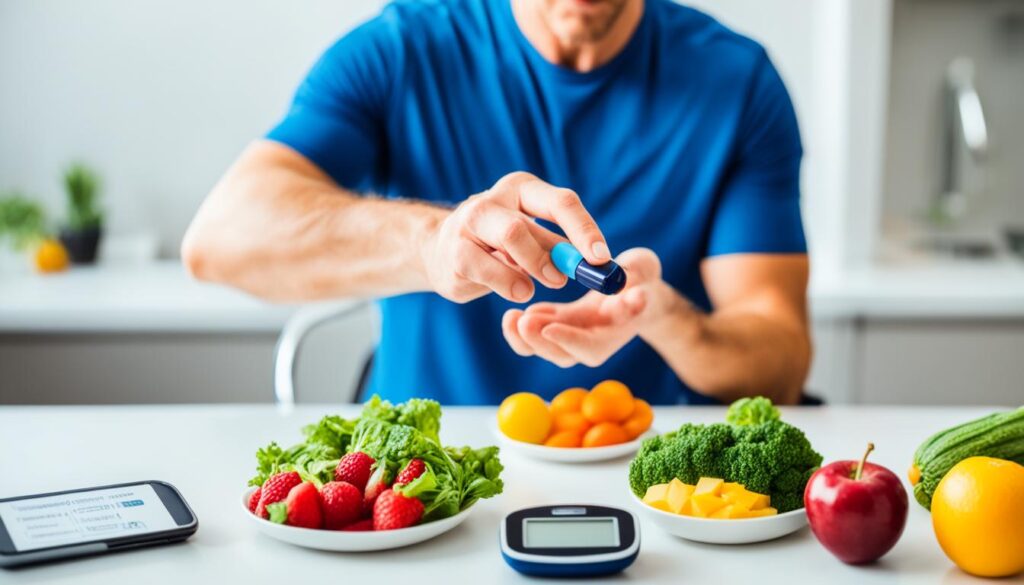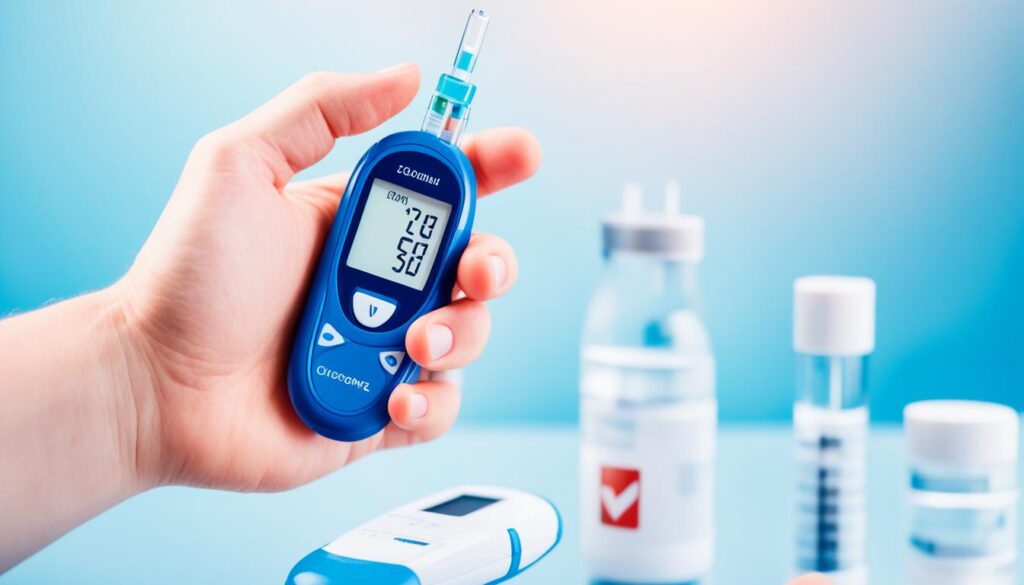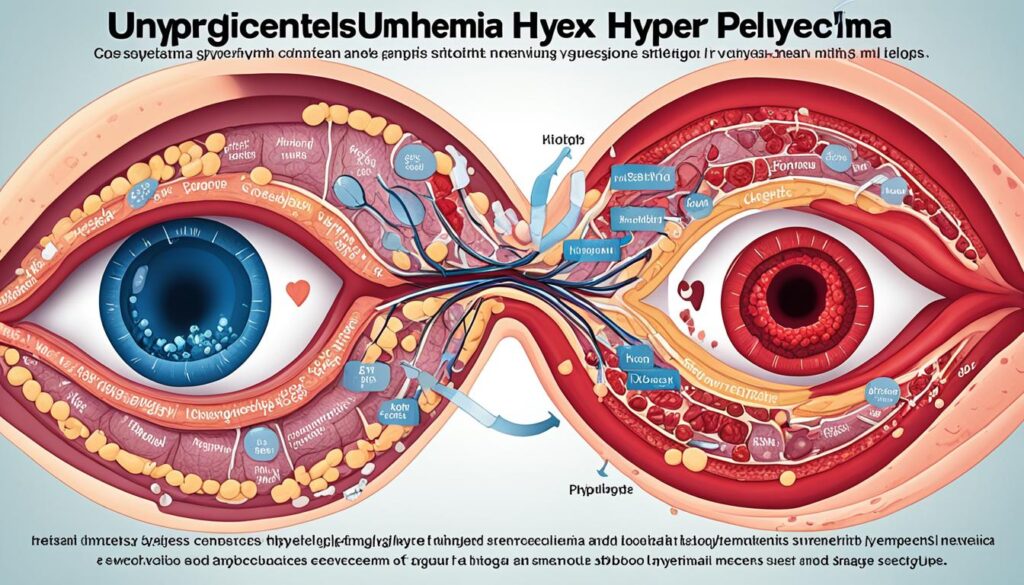High blood sugar, or hyperglycemia, is a common issue for people with1 diabetes. It happens when the body can’t use or control insulin well. This hormone helps manage blood sugar levels. To treat high blood sugar, you need to make lifestyle changes, manage your meds, and watch your blood glucose closely.
The aim is to keep your blood sugar in a healthy range. This helps prevent or slow down serious diabetes problems.

Key Takeaways
- Keeping your blood sugar in check is key to managing diabetes and avoiding complications.
- You’ll likely need to make lifestyle changes, take meds, and keep an eye on your blood sugar levels.
- Staying active, eating right, and taking your meds as directed can help control your blood sugar.
- Using a glucose meter and getting regular A1C tests are important for tracking your progress.
- Getting advice from a healthcare provider is crucial for a personalized treatment plan.
Understanding Target Blood Sugar Ranges
Keeping blood sugar levels healthy is key for people with diabetes. The American Diabetes Association (ADA) sets different targets based on age, diabetes type, and other health conditions2.
Recommended Levels Before Meals
For adults with type 1 or type 2 diabetes, the ADA recommends blood sugar levels of 80-130 mg/dL before eating2. Kids with type 1 diabetes should aim for 90-130 mg/dL before meals2. Pregnant women with type 1 diabetes or gestational diabetes should keep levels under 95 mg/dL before meals2.
Recommended Levels After Meals
After eating, adults with type 1 or type 2 diabetes should keep blood sugar under 180 mg/dL2. Kids with type 1 diabetes should aim for 90-150 mg/dL at bedtime and overnight2. Pregnant women with type 1 diabetes or gestational diabetes should aim for 140 mg/dL or less 1 hour after meals, and 120 mg/dL or less 2 hours after meals2.
Remember, these targets can change based on your health. Always talk to your doctor to find the best targets for you2.
| Scenario | Recommended Blood Sugar Levels |
|---|---|
| Adults with type 1 or type 2 diabetes | Before meals: 80-130 mg/dL After meals: Less than 180 mg/dL |
| Children with type 1 diabetes | Before meals: 90-130 mg/dL Bedtime/Overnight: 90-150 mg/dL |
| Pregnant individuals with type 1 diabetes or gestational diabetes | Before meals: Less than 95 mg/dL 1 hour after meals: Less than 140 mg/dL 2 hours after meals: Less than 120 mg/dL |
| Individuals aged 65 or older | 80-180 mg/dL |
| People without diabetes | Before meals: 72-99 mg/dL After meals: Less than 140 mg/dL |
Continuous glucose monitoring (CGM) can give a full view of blood sugar levels and help manage diabetes better2. Studies show CGM can improve diabetes care, especially for those who don’t feel low blood sugar2.
“Keeping blood sugar in check is key to managing diabetes and avoiding problems. Always work with your doctor to set the right targets for you.”
Home Blood Sugar Monitoring
Checking your blood sugar levels at home is key to managing high blood sugar. Your doctor will tell you how often to check, based on your treatment and diabetes control. This monitoring helps you see how different things like food, exercise, and medicine affect your blood sugar. It lets you adjust your habits to keep your levels healthy3.
Issued In Public Interest
There are two main ways to check blood sugar at home: with a glucose meter and finger sticks, or with a continuous glucose monitor (CGM)3. Finger sticks give you a quick reading of your blood sugar at that moment. You might need to do this several times a day, especially if you use insulin3. CGMs, on the other hand, track your blood sugar levels all the time. They give you a full picture of how your sugar levels change over days, helping you understand your body better3.
- Type 1 diabetes patients are advised to use a CGM or test their blood sugar 4 to 10 times a day4.
- Type 2 diabetes patients who take insulin may require CGM or multiple daily blood sugar tests4.
- Continuous Glucose Monitors (CGMs) measure blood sugar every few minutes and usually last 10 days to two weeks4.
- Newer CGMs don’t seem to be affected by standard doses of certain medications such as acetaminophen4.
It’s important to keep track of your blood sugar levels using apps or written records. This helps you keep a history of your sugar levels for better diabetes care3. Make sure to talk to your doctor and insurance about the right diabetes management tools for you. They should cover things like glucose meters, test strips, and CGMs3.
“Monitoring blood sugar is essential for diabetes management, especially for insulin users, helping them make decisions about food, activity, and insulin dosing.”3

Importance of Hemoglobin A1C Test
The hemoglobin A1C test is key for checking how well people with diabetes control their blood sugar over time. It looks at the average amount of glucose on red blood cells for the past 2-3 months. This gives important info on how well someone is managing their diabetes5.
For most adults with diabetes, an A1C level of 7% or less is the goal. This shows good blood sugar control and lowers the risk of diabetes problems5. The test results are shown as a percentage. Levels below 5.7% are normal, 5.7% to 6.4% mean prediabetes, and 6.5% or higher on two tests confirms diabetes5.
Using a glucose meter at home to check blood sugar is also important. But the A1C test is a key part of managing diabetes well. The goal is to keep blood sugar levels below 154 mg/dL (8.6 mmol/L) for an A1C under 7%5.
| Hemoglobin A1C Level | Estimated Average Blood Sugar |
|---|---|
| 6% | 126 mg/dL (7 mmol/L) |
| 7% | 154 mg/dL (8.6 mmol/L) |
| 8% | 183 mg/dL (10.2 mmol/L) |
| 9% | 212 mg/dL (11.8 mmol/L) |
| 10% | 240 mg/dL (13.3 mmol/L) |
But, the A1C test might not always be accurate for everyone. This includes people with anemia, certain blood types, or recent blood loss or transfusions5. For these cases, other tests might be needed for reliable results6.
“The hemoglobin A1C test provides a window into a person’s long-term blood sugar management, helping guide diabetes treatment decisions and reduce the risk of complications.”
Checking A1C levels regularly, along with other strategies, is key for good blood sugar control. This helps lower the risk of serious health issues5.
Symptoms and Causes of Hyperglycemia
Hyperglycemia, or high blood sugar, is a common issue for people with diabetes7. About 1 in 10 people in the U.S. have diabetes. It’s key to know the early signs and long-term effects of high blood sugar7. Fasting hyperglycemia means blood sugar is over 130 mg/dL after not eating for at least 8 hours7. Postprandial hyperglycemia is when blood sugar is over 180 mg/dL 2 hours after eating for those with diabetes7.
Early Signs of High Blood Sugar
Early signs of hyperglycemia include feeling very thirsty and needing to pee a lot, blurry vision, and headaches7. These signs can start slowly over days or weeks. Some people might not notice any symptoms until their blood sugar is very high8.
Long-term Effects of Hyperglycemia
If not treated, high blood sugar for a long time can cause more serious issues. These include feeling very tired, losing weight, and cuts and sores that don’t heal well7. It can also damage the eyes, nerves, kidneys, and blood vessels. In severe cases, it can lead to life-threatening conditions like diabetic ketoacidosis (DKA) and hyperosmolar hyperglycemic state (HHS)8.
High blood sugar is often caused by not having enough insulin, not responding well to insulin, or damage to the pancreas9. Other things that can raise blood sugar include stress, being sick, what you eat, not exercising enough, not drinking enough water, problems with medicines, over-treating low blood sugar, and some medicines8. It’s vital to watch for signs and check blood sugar levels often to stop serious problems9.

“Hyperglycemia can result in serious health problems if left untreated. Very high blood sugar levels can lead to life-threatening conditions such as diabetic ketoacidosis (DKA) and hyperosmolar hyperglycaemic state (HHS).”8
Managing High Blood Sugar Through Lifestyle Changes
Managing high blood sugar needs a mix of strategies. Making key lifestyle changes is key. A plan that includes diabetes diet, physical activity for diabetes, and healthy habits helps control blood sugar. This approach lowers the risk of serious health problems later.
Healthy Eating for Diabetes
A diabetes-friendly diet focuses on eating the right amounts, choosing high-fiber foods, and cutting down on refined carbs and sugars. A dietitian can help create a meal plan that fits your needs and likes10.
Regular Exercise and Physical Activity
Regular exercise is great for managing high blood sugar. The American Diabetes Association suggests adults aim for 150 minutes of moderate activity each week10. This can be brisk walking or other aerobic exercises. It helps make insulin work better and lowers blood sugar.
Adults should try to do 30 minutes of moderate activity daily, and add strength exercises 2 to 3 times a week10. Exercise can keep blood sugar stable for a day after. But, it can cause low blood sugar, especially if you’re new to it or do intense activities10. It’s important to check your blood sugar before, during, and after exercise. Have a plan ready to handle any changes in blood sugar10.
Drinking enough water and managing insulin during exercise are also key to keeping blood sugar in check10. By changing your lifestyle and working with your healthcare team, you can manage high blood sugar well. This reduces the risk of diabetes-related problems1011.

Medications for Treating High Blood Sugar
If lifestyle changes aren’t enough to manage high blood sugar, or hyperglycemia, you might need medication. Metformin is often the first choice, as it lowers glucose production and makes insulin work better12. But in May 2020, the FDA asked for some extended-release metformin tablets to be taken off the U.S. market because they had a harmful substance12.
Other oral diabetes medications like sulfonylureas, DPP-4 inhibitors, and GLP-1 agonists can also help control blood sugar levels13. For some, insulin therapy might be needed to keep blood sugar in check12. Your doctor will help pick the best diabetes medication or treatment mix for you.
Insulin Therapy Options
Insulin is key for treating type 1 diabetes, with many types available in the U.S., both brand and generic12. The time it takes to work varies, lasting from a few hours to a full day12. Amylinomimetic injectables, like Pramlintide, are used before meals to lower blood sugar in type 1 diabetes12.
Metformin and Other Oral Medications
For type 2 diabetes, oral diabetes medications are often used, sometimes with insulin or injectables12. Biguanides, like metformin, are common and can be mixed with other diabetes medications12. DPP-4 inhibitors help lower blood sugar safely13. GLP-1 receptor agonists are added to diet and exercise plans for type 2 diabetes to improve blood sugar control13.
| Medication Class | Examples | Mechanism of Action |
|---|---|---|
| Biguanides | Metformin | Reduces glucose production in the liver and improves insulin sensitivity |
| Sulfonylureas | Glipizide, Glyburide, Glimepiride | Stimulates beta cells in the pancreas to release more insulin |
| DPP-4 Inhibitors | Sitagliptin, Saxagliptin | Helps reduce blood sugar without causing hypoglycemia |
| GLP-1 Receptor Agonists | Exenatide, Liraglutide | Promotes better glycemic control when used with diet and exercise |
| SGLT2 Inhibitors | Canagliflozin, Empagliflozin | Reduces glucose reabsorption in the kidneys to lower blood sugar levels |
Your healthcare provider will choose the right diabetes medications and treatment mix based on your needs and how you respond to them13.

Monitoring and Testing for High Blood Sugar
It’s key to check your blood sugar often to manage high levels, also known as hyperglycemia. Your doctor might suggest using a continuous glucose monitor (CGM) for a better look at your blood sugar levels all day and night14. Testing your A1C level is also important to see how well you’re controlling your blood sugar over time14. This helps you and your doctor make smart choices about your diabetes care.
Using a glucose meter at home is a good way to keep track of your blood sugar14. You can test different spots like your fingers, forearm, thigh, or hand, and you’ll get instructions on how to use the meter14. Keeping a record of your readings and noting what you eat, do, and other factors that affect your levels is crucial14.
If you use insulin, are pregnant, having trouble hitting your blood sugar goals, or often have low blood sugar without warning, your doctor might want you to check your blood sugar more often14. They might also suggest testing for ketones in your urine when your blood sugar is high or if you’re sick, telling you when to do it14.
Continuous glucose monitoring (CGM) gives you a detailed look at your blood sugar levels, showing trends and patterns day and night15. It’s especially useful for people with type 1 diabetes to check how well their treatment is working15. The goal is to spend at least 70% of the day with your glucose levels between 70 and 180 mg/dL15.
Along with home testing, checking your A1C level regularly is key for seeing how well you’re controlling your blood sugar over time15. An A1C level of 6.5% or higher means you have diabetes, 5.7% to 6.4% means you’re at risk, and below 5.7% is normal15. The American Diabetes Association says most adults with diabetes should aim for an A1C under 7%, but this can vary based on your health and other factors14.
Regular monitoring and testing are vital for managing high blood sugar and making sure your diabetes treatment works well. By working with your healthcare provider, you can make the best choices for your blood sugar control and health.

| Measure | Target Range |
|---|---|
| Preprandial (before meal) plasma glucose | 80-130 mg/dL |
| Postprandial (after meal) plasma glucose | Less than 180 mg/dL |
| Hemoglobin A1C (HbA1C) | Less than 7% for most adults with diabetes |
| Time in range (CGM) | 70% or higher between 70-180 mg/dL |
“Regular monitoring and testing are essential for managing high blood sugar and ensuring your diabetes treatment plan is effective.”
Complications of Uncontrolled Hyperglycemia
Keeping blood sugar levels healthy is key to avoiding serious diabetes complications. High blood sugar, or hyperglycemia, can cause severe health problems over time16. For those with diabetes, a blood sugar level above 180 milligrams per deciliter (mg/dL) after eating is too high16. On the other hand, levels below 70 mg/dL are too low and can be dangerous, especially if under 40 mg/dL16.
Diabetic ketoacidosis (DKA) is a major risk from untreated high blood sugar16. DKA happens when blood sugar goes over 240 mg/dL, causing ketones and acidic blood16. It can lead to serious symptoms like trouble breathing, vomiting, muscle stiffness, thirst, dry skin, and confusion16.
Hyperosmolar hyperglycemic syndrome (HHS) is another severe condition from high blood sugar16. HHS shows with extreme thirst, dehydration, warm dry skin, high fever, confusion, weakness, and vision loss when blood sugar hits 600 mg/dL or more16. It mainly affects older adults and those with poorly managed diabetes16.
Long-term high blood sugar also causes chronic health issues17. These can include heart disease, nerve damage, kidney damage, vision problems, diabetic coma, heart attack, stroke, and skin issues17.

To avoid these serious problems, it’s vital to check blood sugar often and work with a healthcare provider to manage diabetes17. Recognizing and treating high blood sugar early is crucial for staying healthy17.
Conclusion
Managing high blood sugar well means making big changes in your life, using the right medicines, and keeping an eye on your blood sugar levels18. Working with your doctor, you can make a plan that keeps your blood sugar safe and lowers the risk of problems19. Eating right and staying active are key to managing high blood sugar and feeling better overall18.
Studies show how important blood sugar levels are for your health. They affect how long you live, how well you heal after surgery, and your chances of getting other diseases20. Knowing what affects your blood sugar, like what you eat, your meds, how active you are, and your genes, helps you control diabetes better1819.
Getting your blood sugar under control is an ongoing effort that needs commitment and teamwork with your healthcare team. With the right steps and a focus on healthy living with diabetes, you can manage your blood sugar and boost your health1819.
FAQ
How do you treat high blood sugar?
To treat high blood sugar, you need to make lifestyle changes and manage your medication. It’s also important to keep an eye on your blood glucose levels. This helps prevent serious problems.
What are the recommended target blood sugar levels?
The Mayo Clinic suggests blood sugar levels between 80-120 mg/dL before meals. After meals, it should be less than 180 mg/dL. These levels can change based on your health and other factors.
Why is routine blood sugar monitoring important?
Checking your blood sugar regularly is key. It helps you see how your body reacts to food, exercise, and medicine. This way, you can adjust things to keep your blood sugar right.
What is the hemoglobin A1C test and why is it important?
The hemoglobin A1C test checks your blood sugar over the past 2-3 months. It shows if your blood sugar has been under control. An A1C level of 7% or less means your blood sugar has been well-managed.
What are the symptoms and causes of high blood sugar?
Early signs of high blood sugar include feeling thirsty and needing to pee a lot, blurry vision, and headaches. Over time, it can cause serious problems. High blood sugar can happen if you don’t have enough insulin, your body resists insulin, or your pancreas is damaged.
How can lifestyle changes help manage high blood sugar?
Changing your lifestyle is key to managing high blood sugar. Eating right means controlling portions, eating foods high in fiber, and cutting down on refined carbs and sugar. Exercise can also help by making your body more sensitive to insulin and lowering blood sugar.
What medications are used to treat high blood sugar?
If diet and exercise aren’t enough, you might need medication. Metformin is often the first choice. Other drugs or insulin therapy might be needed depending on your situation.
How do you monitor and test for high blood sugar?
Checking your blood sugar often is crucial. You can use a home glucose meter. Your doctor might also suggest continuous glucose monitoring (CGM) and A1C tests to check your long-term blood sugar control.
What are the potential complications of uncontrolled high blood sugar?
High blood sugar over time can cause nerve damage, kidney disease, heart disease, and eye problems. Severe hyperglycemia can lead to diabetic ketoacidosis, a serious condition.
Source Links
- Hyperglycemia in diabetes-Hyperglycemia in diabetes – Diagnosis & treatment – Mayo Clinic – https://www.mayoclinic.org/diseases-conditions/hyperglycemia/diagnosis-treatment/drc-20373635
- Helping You Understand ‘Normal’ Blood Sugar Levels – https://www.healthline.com/health/diabetes/normal-blood-sugar-level
- Blood Sugar Monitoring: Why, How & When To Check – https://my.clevelandclinic.org/health/treatments/17956-blood-sugar-monitoring
- Blood sugar testing: Why, when and how – https://www.mayoclinic.org/diseases-conditions/diabetes/in-depth/blood-sugar/art-20046628
- A1C test – Mayo Clinic – https://www.mayoclinic.org/tests-procedures/a1c-test/about/pac-20384643
- The Hemoglobin A1c Test & Chart – https://www.webmd.com/diabetes/glycated-hemoglobin-test-hba1c
- Hyperglycemia and Diabetes – https://www.webmd.com/diabetes/diabetes-hyperglycemia
- Hyperglycaemia (high blood sugar) – https://www.nhsinform.scot/illnesses-and-conditions/blood-and-lymph/hyperglycaemia-high-blood-sugar/
- Hyperglycemia (High Blood Glucose) | ADA – https://diabetes.org/living-with-diabetes/treatment-care/hyperglycemia
- Diabetes management: How lifestyle, daily routine affect blood sugar – https://www.mayoclinic.org/diseases-conditions/diabetes/in-depth/diabetes-management/art-20047963
- 6 Lifestyle Changes to Help Control Your Diabetes – https://www.webmd.com/diabetes/diabetes-lifestyle-tips
- List of Common Diabetes Medications – https://www.healthline.com/health/diabetes/medications-list
- What Are My Options for Type 2 Diabetes Medications? – https://diabetes.org/health-wellness/medication/oral-other-injectable-diabetes-medications
- Diabetes Tests | ADA – https://diabetes.org/living-with-diabetes/treatment-care/checking-your-blood-sugar
- Diabetes – Diagnosis and treatment – Mayo Clinic – https://www.mayoclinic.org/diseases-conditions/diabetes/diagnosis-treatment/drc-20371451
- What Can Happen if My Blood Sugar Is Out of Control? – https://www.webmd.com/diabetes/uncontrolled-blood-sugar-risks
- Hyperglycemia in diabetes-Hyperglycemia in diabetes – Symptoms & causes – Mayo Clinic – https://www.mayoclinic.org/diseases-conditions/hyperglycemia/symptoms-causes/syc-20373631
- 42 Factors That Affect Blood Glucose – https://diabetesresearchconnection.org/42-factors-affect-blood-glucose/
- Hyperglycemia | High Blood Sugar | Diabetes | MedlinePlus – https://medlineplus.gov/hyperglycemia.html
- Blood glucose levels should be considered as a new vital sign indicative of prognosis during hospitalization – https://www.ncbi.nlm.nih.gov/pmc/articles/PMC8049470/